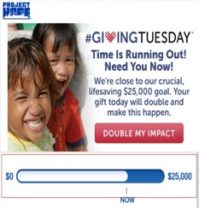Behavioral Science Tips for #GivingTuesday and Year-End
The other day a Tweet from Aimee Vance (@NPOfriend) caught my eye with the question: End of Year Goal Thermometer on the donation page. Yea? Nay? What say ye?
 The string of replies were all over the lot: “Depends”….”Hard NAY—unless the volunteers/board helping meet the goal have it as part of their culture already. We could discuss this a lot, and I’d get to NO nearly every time.” …”I only use thermometers when funding is over the 70% threshold. Otherwise it could signal negative social proof.”… “If it shows impact, yes. Otherwise it’s an internal measure that is not meaningful.”
The string of replies were all over the lot: “Depends”….”Hard NAY—unless the volunteers/board helping meet the goal have it as part of their culture already. We could discuss this a lot, and I’d get to NO nearly every time.” …”I only use thermometers when funding is over the 70% threshold. Otherwise it could signal negative social proof.”… “If it shows impact, yes. Otherwise it’s an internal measure that is not meaningful.”
I figured this and similar questions are popping up with increasing frequency as folks prepare #GivingTuesday and your Year-End Campaigns.
So, I dove into the Agitator Archive and extracted some advice and findings from Nick, Kiki and me that may prove especially helpful at this time of year.
First, Some Behavioral Science Grounding
No need to guess about whether or how to use a thermometer or what the best annual renewal offer may be. There’s plenty of behavioral science research out there to guide you.
By way of backgrounding to help you think about alternative approaches read my post Behavioral Science & Fundraising: The Desire for Completion. Here you’ll find out the behavioral science reasons why the “thermometer” works and why it’s good to have that rising red column of mercury nearing the top rather than hovering at the bottom.
The “thermometer” effect works on the behavioral science principle of “task completion” or “goal proximity.” AND… you can amp up the effects of those principles by adding one more principle – “The Endowed Progress Effect”. As I note in the post you might consider combining these principles if you want to significantly boost the size/frequency/efficiency of your annual gifts. An example is provided in the post.
Thermometer and Year-End Goals
 Nick adds more detail on goal setting and tactics in his Getting to Your Year-End Gooooooooaaaal! He explains why you can probably increase your year-end revenue by using what behavioral scientists call “goal proximity”. Even better you’ll benefit from research findings that the closer the thermometer is to full the more likely someone is to give.
Nick adds more detail on goal setting and tactics in his Getting to Your Year-End Gooooooooaaaal! He explains why you can probably increase your year-end revenue by using what behavioral scientists call “goal proximity”. Even better you’ll benefit from research findings that the closer the thermometer is to full the more likely someone is to give.
Best of all he suggests ways in which to use the thermometer. For year-end giving, but only after #GivingTuesday (he explains why the timing is important)…how the thermometer can be used to trigger giving by your board…and even in boosting results in reinstatement campaigns.
The thermometer works in digital and in direct mail. At the end of Nick’s post you’ll find additional and helpful suggestions from other fundraisers.
#GivingTuesday: 4 Behavioral Science Tips
Kiki Koutmeridou, the Chief Behavioral Scientist at DonorVoice, has studied enough #GivingTuesday emails to make a dog sick. Out of that morass in 4 Behavioral Science Tips for #GivingTuesday she offers these observations:
- The majority of nonprofits are using a match offer for #GivingTuesday. I won’t argue against such an offer here. We’ve covered this many times before.
- Most make use of urgency– but nowhere near its full potential.

- There’s enormous missed opportunities by not using additional behavioral science principles.
Here are four crucial principles that should be included or optimized:
1, Urgency Visualization. Creating a sense of urgency helps tackle procrastination. Most #Giving Tuesday appeals use urgency language (“soon”…”hurry”…”time is running out”) but the power of images –like a countdown clock—is either neglected or simply forgotten.
2, Exceptional occurrence or expense. Minor differences in the way a charity frames an appeal, as either a regular occurrence or an exceptional on—can make a big difference in how likely people are to donate. See the examples in Kiki’s post.
3, Goal proximity and visualization. Folks are more motivated to act when there is a target, but as indicated in Nick’s and my posts on the “thermometer”, they’re even more motivated when some progress has been made towards the target goal. The greater the progress, the more people respond.
4. Contingent framing for goal attainability. Other than using this term to boost your fees or impress your office pals, this is a fascinating adaptation of the matching gift offer. Kiki notes that #GivingTuesday may not be the ideal place to use this concept. But on the other hand, she believes it has great potential and suggests some ways those thinking about #GivingTuesday can put it to work. Her #Giving Tuesday post is here.
Here’s hoping you’ve found some ideas and applications you can put to work or test in this jam-packed season. Ideas that could distinguish you from others in what at this time of year too often is a sea of sameness.
And, please share your thoughts, results and questions in the Comments section below.
Roger



Thanks for this!
Very useful